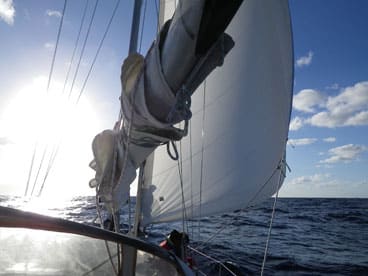
Passage to Bermuda
Tioga was launched in 1978, and in the 1980s, with the name Boomerang, her owner took her across the Atlantic and back with various family members aboard, including his son Bob Baldwin, who’d eventually become a Nahant neighbor. Several of us from town joined Bob and his dad, Big Bob, aboard Boomerang for the 2005 Figawi race, and I’ll admit that for a few of us aboard the boat for the first time, it was love at first sight. The following winter, Big Bob decided it was time to move up to a new Boomerang, and Philip, part of that Figawi crew, got himself a heck of a deal when he made an offer for the trade-in. He renamed his new boat Tioga.
An accomplished racing sailor growing up in his native Germany, Philip had big plans for the family’s new sloop. Soon he was upgrading systems and, with the help of friends, making repairs in order to do a passage to Bermuda and back. Planning is second nature for Philip, who’s a software-implementation project leader by day. He drew up lists of tasks, tools, menus, and watch schedules. Over beers, potential crew gathered to go over details and look at charts, and they even practiced their suturing skills on sliced-open pigs feet, just in case. Then during the summer of 2008, Captain Philip and assorted friends sailed across the Stream, left the boat in Bermuda for a spell, then returned to bring the boat home. For several aboard, it was their first trip offshore, and, it turns out, it served as a training opportunity for the voyage to come because even then, the skipper was planning his next big escapade, a winter in the Caribbean. The model would be the same—captain and crew would share in preparations, sailing, and expenses—though this trip would be more complicated because of its four distinct legs and the time commitments required for each.
Tioga comfortably accommodates six for extended periods, and that number also works well for watch rotations. For the Caribbean voyage, each leg had three watch captains, standing three on and six hours off. Meanwhile, a different watch mate each morning stood a six-hour shift, so pairings rotated daily. Since Philip would be captain for all four legs, that left 20 berths to fill. Or to put it another way, it left the rest of us 20 opportunities to make an extended offshore passage, with each berth costing well less than $1,000 a piece. For captain and crew, the trip would be both bargain and adventure.
By early 2010, the Caribbean crew roster began to take shape. In all, 14 of us would claim at least one spot, and each in his or her own way would help with preparations. Projects included replacing the standing rod rigging, repairs to the stuffing box and shaft coupling, electrical upgrades, fitting out a new working genoa, and rounding up supplies.
To keep track of the jobs as well as the tools, safety, and emergency equipment being collected, Philip used Google Docs and posted detailed spreadsheets of what had been accomplished and what remained to be done. Crews of the various legs were assigned buddies who’d share as much gear as possible—P.F.D.s, harnesses, sleeping bags, even rain gear—to cut down on clutter.
By late August 2010, details had come together, and the teams for each respective leg met on the boat for training. During our session, we set every sail, including the inner-forestay and hanked-on storm canvas, practiced crew-overboard drills, and identified the locations of through-hulls, bilge pumps, first-aid equipment, and other emergency supplies.
It was agreed that each crewmember would cook and freeze one dinner ahead of time. On the morning of our departure, these were packed in coolers with dry ice, and we checked them as baggage. Because our leg would span Thanksgiving, a chef friend, Peter Davis of Henrietta’s Table, at the Charles Hotel in Cambridge, was kind enough to prepare, vacuum-pack, and freeze a seventh dinner consisting of turkey and all the fixings, which we figured we’d heat in boiling water midocean somewhere.
With the food packed, we headed for the airport.
Meanwhile, Philip and his crew finished their first leg from Nahant, Mass. to St. George, Bermuda. They had a rough first night, with accidental jibes as they passed first Cape Cod and then Nantucket. A batten was torn from the main, and the hydraulic vang was damaged. Still, they sailed on, through headsail changes, squalls, calms, and quirky breezes that kept them too long in the Gulf Stream. Eventually though, they cracked beers all around as they made landfall, seven days after their departure.
Read the next chapter of our adventure here, and find our entire trip here.







